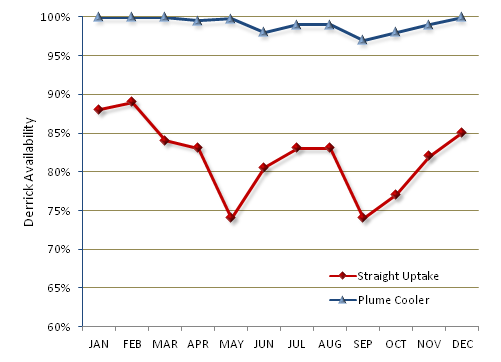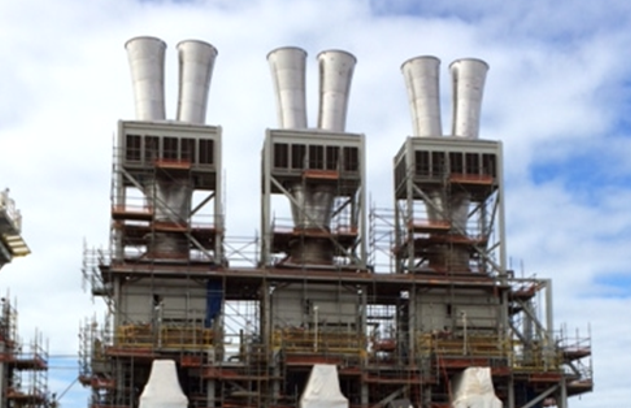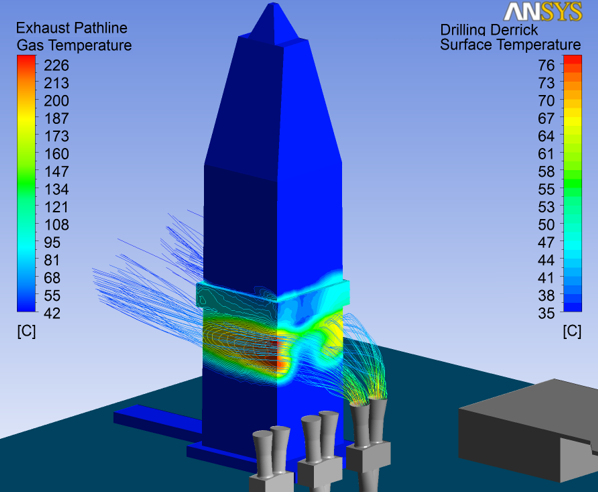Marine Exhaust Cooling
- Offshore oil platform topsides contain the drilling rig, engine exhaust stacks, helicopter landing pad, and other equipment all situated in close proximity. The engine exhaust gas exits the stack at a high temperature – in the case of gas turbines at greater than 550°C (1022°F).
Wind can carry the exhaust plume so that it impinges on sensitive equipment, blow into areas which are occupied by personnel, or interfere with helicopter flight. In these conditions the operation of the rig is disrupted, for example by requiring the drill rig to be shut down, or the helipad to be made inaccessible.
Topside designers must understand with what frequency the rig operation will be affected by climatic conditions blowing the exhaust plume into sensitive areas. If the disruption is predicted to be too common in the region of operation, then the exhaust arrangement must be modified. Four options are available, and can be used in combination:
- ● Move the exhaust stack exit further away from areas of concern;
- ● Raise the exhaust stack exit in height;
- ● Cool the exhaust gas; and/or
- ● Break the exhaust into multiple parts so that it dissipates more quickly.
- Davis can assist in both understanding the extent of a hot exhaust plume problem and also in proposing and analysing the benefit of possible solutions.
- We employ a two-step process. The first step is to predict impingement temperatures in sensitive areas over the full range of possible wind speeds and directions. Using these results in combination with data on the likelihood of these wind characteristics allows us to understand with what frequency temperatures are too high. This prediction is performed with a validated empirical software model which calculates buoyant exhaust plume trajectories in a free stream (but does not take account of rig structure). Also during this first step, any of the above four possible solutions can be analysed independently or in combination.
- An example output of this analysis is provided in this chart. The chart shows the availability by month of operation of a drilling derrick both for a simple exhaust stack and also for a stack which cools the exhaust gas and splits the plume into two. These results were obtained from an actual oil platform and exhaust gas cooling design being deployed in the Gulf of Mexico. In this case, the limit on impingement temperature for an identified sensitive area of the derrick is 80°C (176°F).
 Predicted Derrick Availability by Time of Year
Predicted Derrick Availability by Time of Year- Employing an exhaust gas cooling device is typically the most cost effective solution. Moving the stacks to exit at a further location is typically expensive in terms of space and cost. Raising the stack exit to a height at which no impingement occurs is very expensive given at what height the exit must be located.
- The second step is to refine the analysis by modeling the oil platform structure in three dimensions in a Computational Fluid Dynamics (CFD) code. Both the CFD modeling and the computational time is more time intensive and so only a few scenarios are analysed. These scenarios are chosen from the most critical conditions identified during the first step.
- A sample CFD output is provided in the picture below. The CFD tool can be used to understand the exhaust plume trajectory and also the distribution of impingement temperatures on the equipment.


